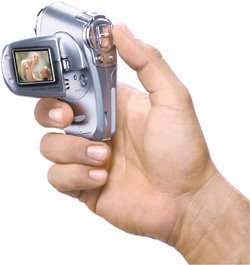Working in Other Video Formats
| If you're like the vast majority of iMovie HD users, you shoot and edit in the DV formatthe most popular digital video format. But iMovie HD isn't limited to the DV format. As described on pages 224 and 225, iMovie HD also lets you work in the HDV, iSight, and MPEG-4 formats. As I mentioned previously, iMovie HD's basic operation is identical regardless of which format you use. But there are some subtle differences between formats. Some formats use more disk space than othersa lot more. Some formats allow for device controlthe ability to have iMovie HD operate your camera's mechanism when importing or exporting videowhile others require different importing techniques. Here's a look at the differences you're most likely to encounter as you work with iMovie HD, and some tips for using various formats. HDV Differences With 1080i, each frame contains 1,080 horizontal scan lines. The scan lines are drawn in interlaced fashion, like standard-definition TV: first the odd-numbered scan lines, then the even-numbered ones. The 1080i format provides the best image quality, but its footage uses considerably more disk space than 720p footage. And because each video frame contains more data that iMovie HD must process, transitions, effects, and titles take longer to render with 1080i footage. MPEG-2 and intermediates. With HDV, video is stored in MPEG-2 format. Because of the way MPEG-2 data is structured, it can't easily be edited on a frame-by-frame basis. (See page 307 for an introduction to how MPEG-2 video is structured.) In order to make MPEG-2 video editable, iMovie HD converts video into an intermediate format that is easily editable. This conversion process uses a compression scheme called the Apple Intermediate Codec (AIC). It's this process of converting incoming MPEG-2 that creates the "tape delay" importing effect I described on page 227. Only the fastest Macs are able to transcode MPEG-2 into AIC and display the video in real time. On slower Macs, iMovie HD stashes the MPEG-2 data on your hard drive and transcodes it at whatever pace your Mac is capable of. A similar but much longer delay occurs when you export HDV video back to a camera, at which time iMovie HD must convert from the Apple Intermediate Codec to MPEG-2 format. iSight Insights Apple's inexpensive iSight camera turns your Mac into a hard disk-based camcorder. Connect an iSight to a laptop Mac (or use the iSight built into the MacBook Pro or iMac), and you can shoot video anywhere. Shoot some iSight video, throw in some photos from your iPhoto library if you like, then ship the project off to iDVD. Recording. To record video and audio with an iSight, first open its shutter and put iMovie HD into camera mode (click Format reminder. You can record with an iSight camera regardless of the video format your project uses. But you'll get the best results and use disk space most efficiently by choosing the iSight format when you create your project. If you record video into a project containing footage in a different format, iMovie HD will transcode the iSight video you record into your project's format. (See the sidebar on page 225 for more details.) Speaking of disk space, if your project uses the iSight format, your video will use roughly 65MB per minute. Weird video? If iMovie HD is displaying a distorted or oddly cropped iSight image, you may have an older camera that needs updating. Get the latest iSight software at www.apple.com/isight/download. iSight accessories. A couple of inexpensive accessories can make the stand-alone iSight a better iMovie HD companion. For starters, consider a tripod mount. Kaidan (www.kaidan.com) sells an iSight accessory kit that includes an adaptor that lets you mount an iSight on a tripod. Many clever iSight users have also created their own mounts using a few washers and bolts. Do a Google search for iSight tripod for some inspiration. Another accessory you might want is a long FireWire cable to help you to get the camera further from your Macparticularly handy when you're shooting outdoors with a laptop Mac. Using MPEG-4 Video Many cameras can shoot video clips in MPEG-4 format. Gadget gurus are embracing Fisher's FVD-C1 (shown here) and Sanyo's VPC-C4, tiny still/video camera combinations that can shoot up to an hour of video on a memory cardno tape needed. The video quality falls short of what you get from a miniDV camera, but it's surprisingly goodand is far superior to the movie quality most digital cameras provide. Importing. These cameras don't provide FireWire interfaces and device control. To import their video clips, connect the camera to your Mac's USB jack, then locate the camera's icon on your desktop. Open the icon, locate the video footage, and drag it into the iMovie HD window. The same format reminder applies: if you import MPEG-4 video into a project that contains footage in a different format, iMovie HD will transcode the footage into the project's format. |
